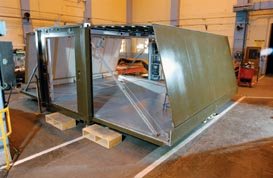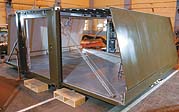| May 2004 IBEW
Journal
The U.S. Armys idea for
a new battlefield device that could help save lives
in combat was as simple as it is revolutionary: build
a quick-deploying, self-contained trauma center and
operating room inside a standard shipping container.
Make it easy to transport and transform into operation
mode. A team at the National Nuclear Security Administrations
Y-12 complex in Oak Ridge, Tennessee, has accomplished
that mandate with the help of a half dozen IBEW Local
760 members.

Dubbed the Future Medical Shelter
System (FMSS), the relatively light 15,000-pound container
can be transported by truck, ship, cargo plane or helicopter.
And it can be dropped, opened and ready to treat wounded
soldiers within 30 minutes.
In April, following more than two
years in development, a prototype of the FMSS was turned
over to the U.S. Army for testing.
The nature of injury and death on
the battlefield prompted the Army to seek an alternative
to the medical delivery system in use today. Prior to
Vietnam, a mobile hospital could be set up close to
the front. But since then, the battlefield has become
a much larger area. Soldiers can travel 15 or 20 miles
in the span of four or five hours; no obvious place
exists for a combat hospital. Most soldiers who die
in combat die from blood loss within an hour of their
injury, said Project Manager Duane Bias of BWXT Y-12.
"You have to get people help
in the golden hour," Bias said. "Todays battlefield
is very hit and move."
Today, medics treating wounded soldiers
travel in a truck loaded with a tent, a couple of cots
and 54 supply boxes, each labeled with a list of its
contents. It takes three hours to set up. By contrast,
it only takes the touch of a button to trigger the hydraulic
mechanism that unfolds the FMSS. In a span of two minutes,
automatic panels spring up to form the sidewalls and
roof. When it is fully opened, the FMSS becomes a 20x20
foot surgical suite with room for a two-table operating
room and support rooms complete with tables, lights
and supplies in moveable cabinets that may be positioned
as required. Moreover, its hearty construction of aluminum
fortified with titanium and butyl rubber provides protection
from nuclear, biological and chemical attack, as well
as small arms fire.
"It was a challenge to me to
be able to take something the engineers had drawn up
and make it a reality," said journeyman wireman
Roger Couch, an employee of BWXT Y-12. "I was working
with extremely skilled craftsmen and we had to put all
of our skills together."
With relatively few modifications,
the system could be developed for other uses, such as
a command and control center or a logistics or operation
center, Bias said. "The potential use for homeland
defense response activities is huge."
Local 760 members were instrumental
in bringing the concept to reality by addressing design
issues related to electronics and the heating and cooling
system that creates the self-contained seal on the FMSS,
Bias said. Couch said making the complex system work
inside an extremely limited amount of space also presented
a challenge.
If the Army decides to move forward
with production of the FMSSand probably no sooner than
2006the Y-12 complexs manufacturing plant has the
capability to produce it, said Garry Whitley, Local
760 shop steward.
"Its rewarding to me that
weve done something that will maybe save peoples lives,"
Couch said. "I feel honored."
The $10 million project cost was
developed for the U.S. Army Medical Research Materiel
Command in Fort Detrick, Maryland. Y-12s portion of
the project was approximately $7 million.


|
